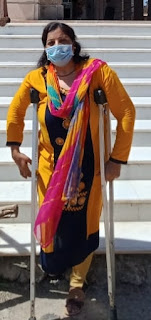Rethink the Language of Accessibility: Global Accessibility Awareness Day #GAAD
I am a wheelchair-user in perpetual pursuit of a barrier-free life. I have been advocating for accessibility on a global scale for over two decades now. And what has become apparent to me over the years is that when advocates like myself talk about accessibility, we are actually talking about something far more profound than what the word itself suggests and something far more transformative than how the word is used.
Accessibility should be a catalytic force for something more. What makes a space accessible is the empathy, connection, freedom and possibility it engenders for people of all abilities and identities to come together.
Accessibility is a slippery, deceptive
word that belies its own emancipatory meaning.
To move beyond the ramp, the sign-language interpreter, the
Braille pad, and reclaim accessibility to mean more than the bureaucratic
administration of disabled bodies, we must move beyond the logic of compliance. Audio and video support, Textbooks That Talk, Apps and website with
accessibility features including alternate text for images and accessible pdfs
are some of the examples.
While we all
align to find the new normal amidst COVID 19 pandemic, today on #GAAD, we are all impacted – especially from a digital
consumption angle. It’s very challenging as digital world is not accessible to
cross disability people. The digital divide has led to discrimination and made
us feel ‘dependent’, while it should be the other way round. In the Coivid-19
lockdown, people with disabilities (PwDs) are more dependent upon smart phones and laptops. A great example is what’s
app, which has connected PwDs with essential services. My another favorite example
is devise like Alexa Echo, which has helped me to undertake small but
independent steps like operating the light switches, AC, TV, living a digitally relaxed life....
For those who
fear that implementing digital accessibility is a daunting effort, here are
some tips or experiences that may be helpful. Will especially direct this to
the product practitioners to touch on both document and web accessibility
including mobile to start with. I
strongly feel that we should work towards larger goal of building an accessible
eco-system. The outreach should be extended beyond the software
programmers, also to cover the ecosystems such as policy, research and allied
fields. Now in India,
accessibility is legal and the deadline also is set, the need for us to talk
and walk digital accessibility is the only best thing for businesses and
society.
There has
always been a fear that incorporating for accessibility may impact other
elements of a web application, such as the look and feel, the overall
performance etc. COVID has shown us that there is room for a lot of innovation
for and by the PwD that benefit non PwD users too. Similarly, there is also a
lot of innovation and new technology that needs to embrace accessibility – for
example, Apple and Google have partnered to work on contract tracing technology
(https://www.apple.com/newsroom/2020/04/apple-and-google-partner-on-covid-19-contact-tracing-technology/).
Looking ahead, it is evident that the
need for accessibility is real – both physical and digital. In the digital
world, it is imperative for websites and mobile apps to be accessible both for
carrying on our regular work from home as well as operational services
including telemedicine, banking, shopping and such essentials. This is
important not just for PwD but also for other users.
With the world turning to accessible modes of staying
connected in the age of social distancing, modes such as video conferencing,
which disabled people were previously shamed for wanting in the workplace,
society is now presented with an opportunity to unleash the transformative
potential of accessibility in how we build back better from the rubble of the
pandemic.
People with disabilities have always known that one can work from home and still be productive. Taking cue from this resourceful and tenacious segment of society, there is no reason why we all can’t embrace more flexible arrangements and fluid working conditions. Perhaps it’s time to accord employees the freedom to determine their own working hours, while maintaining a commitment to results. Perhaps it’s time to match our appreciation for essential workers with better pay. The economic fallout of lockdown has revealed not just the stark reality of financial precariousness but also the extent of financial exclusion.
Beyond Zero, a term I coined to describe a new way of thinking about accessibility, means going beyond the notion that inclusion can somehow be drip fed to people who need it, one tick-box exercise at a time. If we are committed to leaving no one behind then we must stop thinking that ticking boxes leads to accessibility and inclusion.
Human resources, and
human beings in general, need to get over the idea that equality means
sameness. It doesn’t. Equality means our individual and collective differences
are not deal-breakers, at work, at the grocery store, and when we seek medical
care. Perhaps a renewed commitment to accessibility – that confusing, strange
and vital word – may help us see this more clearly.
Tweet/Instagram: access_anjlee



Comments
Post a Comment